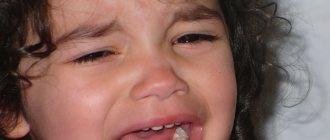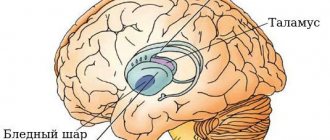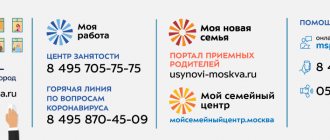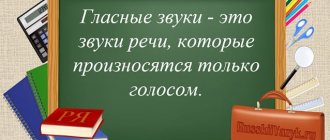Types, levels and forms of speech dysarthria in children
Table of types of disease by location of the lesion
| Name of the pathology form | Peculiarities |
| Cerebellar | Occurs when the cerebellum is involved in the process. Speech is drawn out, slurred, slow, the volume constantly changes, the child’s tongue trembles, he speaks with shouts, as if chanting slogans. Additional symptoms: poor balance, unsteady gait. |
| Bulbarnaya | It is caused by paralysis of the articulatory muscles, as well as the nerves - vagus, glossopharyngeal, ternary, sublingual and/or others. Children lack some reflexes, sucking and swallowing, facial expressions are impaired, and it is difficult for them to chew solid food. There is also increased salivation, simplification (all consonants “merge” into one fricative) and slurred sounds, a nasal, hoarse sound of the voice, sometimes its absence. |
| Pseudobulbar | Occurs with centralized paralysis (spastic) of muscles and their hypertonicity. Speech becomes monotonous, it is difficult for the child to lift the tip of the tongue, move it to the side, or hold it. There is increased salivation, soreness, and swallowing disorders (increased reflex). Speech is slurred, nasal, the pronunciation of hissing, whistling and tone sounds is sharply impaired. |
| Extrapyramidal | It occurs when the function of the subcortical nuclei is disrupted, and therefore received a second name – “subcortical”. Speech is slightly nasal, slurred, and slurred. There are involuntary muscle movements, facial expressions, and articulatory spasms. The timbre and strength of the voice changes, the pace of conversation is disrupted, and there are occasional guttural cries. |
| Cortical | Damage to those areas of the cerebral cortex that are responsible for articulatory muscles. Children pronounce words correctly in structure, but with impaired pronunciation of syllables. There is difficulty breathing during conversation and voice. |
| Cold | Manifests itself as one of the symptoms of myasthenia gravis (fatigue and weakness of striated muscles). Speech disruptions occur when the air temperature in the room where the child is located increases or decreases. |
Classification according to the degree of development of pathology:
- I (erased) - only a speech therapist can identify incorrect pronunciation during examination and examination, almost complete recovery is possible;
- II – pronunciation is clear, but defects are noticeable;
- III – the child is understood only by close people, strangers rarely;
- IV – even relatives do not understand the pronunciation or there is no speech, most often considered within the framework of cerebral palsy.
Important! The erased form is characterized by difficulty chewing solid food. Parents should not change their child's diet because of this. It is necessary to gradually accustom him to chew on the same basis as other people. Source: E.F. Arkhipova Erased dysarthria in children: a textbook for university students // M.: AST: Astrel: KHRANITEL, 2006, p.319
Dysarthria
The speech of patients with dysarthria is slurred, unclear, and incomprehensible (“porridge in the mouth”), which is due to insufficient innervation of the muscles of the lips, tongue, soft palate, vocal folds, larynx, and respiratory muscles. Therefore, with dysarthria, a whole complex of speech and non-speech disorders develops, which constitute the essence of the defect.
Impaired articulatory motor skills in patients with dysarthria may manifest as spasticity, hypotonia, or dystonia of the articulatory muscles. Muscle spasticity is accompanied by constant increased tone and tension in the muscles of the lips, tongue, face, and neck; tightly closed lips, limiting articulatory movements. With muscle hypotonia, the tongue is flaccid and lies motionless on the floor of the mouth; the lips do not close, the mouth is half open, hypersalivation (salivation) is pronounced; Due to paresis of the soft palate, a nasal tone of voice appears (nasalization). In the case of dysarthria occurring with muscular dystonia, when attempting to speak, muscle tone changes from low to increased.
Sound pronunciation disturbances in dysarthria can be expressed to varying degrees, depending on the location and severity of damage to the nervous system. With erased dysarthria, individual phonetic defects (sound distortions) and “blurred” speech are observed.” With more pronounced degrees of dysarthria, there are distortions, omissions, and substitutions of sounds; speech becomes slow, inexpressive, slurred. General speech activity is noticeably reduced. In the most severe cases, with complete paralysis of the speech motor muscles, motor speech becomes impossible.
Specific features of impaired sound pronunciation in dysarthria are the persistence of defects and the difficulty of overcoming them, as well as the need for a longer period of automation of sounds. With dysarthria, the articulation of almost all speech sounds, including vowels, is impaired. Dysarthria is characterized by interdental and lateral pronunciation of hissing and whistling sounds; voicing defects, palatalization (softening) of hard consonants.
Due to insufficient innervation of the speech muscles during dysarthria, speech breathing is disrupted: exhalation is shortened, breathing at the time of speech becomes rapid and intermittent. Voice disturbances in dysarthria are characterized by insufficient strength (quiet, weak, fading voice), changes in timbre (deafness, nasalization), and melodic-intonation disorders (monotony, absence or inexpressibility of voice modulations).
Bulbar dysarthria
Bulbar dysarthria is characterized by areflexia, amymia, disorder of sucking, swallowing solid and liquid food, chewing, hypersalivation caused by atony of the muscles of the oral cavity. The articulation of sounds is slurred and extremely simplified. All the variety of consonants is reduced into a single fricative sound; sounds are not differentiated from each other. Nasalization of voice timbre, dysphonia or aphonia is typical.
Pseudobulbar dysarthria
With pseudobulbar dysarthria, the nature of the disorder is determined by spastic paralysis and muscle hypertonicity. Pseudobulbar paralysis manifests itself most clearly in impaired tongue movements: great difficulty is caused by attempts to raise the tip of the tongue upward, move it to the sides, or hold it in a certain position. With pseudobulbar dysarthria, switching from one articulatory posture to another is difficult. Typically selective impairment of voluntary movements, synkinesis (conjugal movements); profuse salivation, increased pharyngeal reflex, choking, dysphagia. The speech of patients with pseudobulbar dysarthria is blurred, slurred, and has a nasal tint; the normative reproduction of sonors, whistling and hissing, is grossly violated.
Subcortical dysarthria
Subcortical dysarthria is characterized by the presence of hyperkinesis - involuntary violent muscle movements, including facial and articulatory ones. Hyperkinesis can occur at rest, but usually intensifies when attempting to speak, causing articulatory spasm. There is a violation of the timbre and strength of the voice, the prosodic aspect of speech; Sometimes patients emit involuntary guttural screams.
With subcortical dysarthria, the tempo of speech may be disrupted, such as bradyllalia, tachylalia, or speech dysrhythmia (organic stuttering). Subcortical dysarthria is often combined with pseudobulbar, bulbar and cerebellar forms.
Cerebellar dysarthria
A typical manifestation of cerebellar dysarthria is a violation of the coordination of the speech process, which results in tremor of the tongue, jerky, scanned speech, and occasional cries. Speech is slow and slurred; The pronunciation of front-lingual and labial sounds is most affected. With cerebellar dysarthria, ataxia is observed (unsteadiness of gait, imbalance, clumsiness of movements).
Cortical dysarthria
Cortical dysarthria in its speech manifestations resembles motor aphasia and is characterized by a violation of voluntary articulatory motor skills. There are no disorders of speech breathing, voice, or prosody in cortical dysarthria. Taking into account the localization of lesions, kinesthetic postcentral cortical dysarthria (afferent cortical dysarthria) and kinetic premotor cortical dysarthria (efferent cortical dysarthria) are distinguished. However, with cortical dysarthria there is only articulatory apraxia, while with motor aphasia not only the articulation of sounds suffers, but also reading, writing, understanding speech, and using language.
Causes and symptoms
The disease is provoked by a number of harmful factors:
- viral diseases of the expectant mother;
- pathologies of the placenta at the stage of intrauterine development;
- Rhesus conflict;
- fetal hypoxia;
- very rapid or slow labor with cerebral hemorrhage in the child;
- some birth injuries;
- prematurity;
- infections of the brain and its membranes, such as meningitis;
- Cerebral palsy (up to 85% of cases of dysarthria);
- TBI;
- hydrocephalus;
- severe intoxication;
- encephalitis. Source: L.I. Belyakova, Yu.O. Filatova Diagnosis of speech disorders // Defectology, 2007
Symptoms and treatment
The main symptoms include the following:
- incomprehensible, slurred speech;
- spastic manifestations in the articulatory muscles (neck, lips, face, tongue are constantly tense, articulation is limited, lips are tightly closed);
- hypotonia of the articulatory apparatus (lips do not close, tongue lies motionless in the mouth, mouth is slightly open, increased salivation);
- dystonia of articulatory muscles (when a child tries to talk, his muscle tone goes from low to high);
- slurred pronunciation;
- in difficult cases, the child misses sounds, replaces them or pronounces them distorted; Source: O.Yu. Fedosova Features of sound pronunciation of children with mild dysarthria // Speech therapist in kindergarten, 2005, No. 2, pp. 36-41
- slowness of conversation;
- inability to speak (in severe forms);
- nasal voice without signs of a runny nose;
- change, omission, replacement of some sounds with others;
- fading of a phrase towards the end of its utterance, rapid breathing during a conversation due to lack of air;
- very high, almost “squeaky” voice;
- a fast or very slow flow of words, while the child cannot change the tone.
What to do? Treatment methods for the disorder
The child must undergo additional classes with a speech therapist (at home or in a special institution) on:
- development of motor skills;
- forming a conversation;
- honing diction;
- correcting the pronunciation of distorted sounds;
- expanding vocabulary;
- development of phonetic hearing;
- memorizing grammatical structure.
Against this background, drug therapy is carried out using nootropics. Medicines in this group specifically affect brain functions: stimulate mental activity, cognitive functions, increase learning abilities, and improve memory.
The package of measures also includes exercise therapy - articulation gymnastics to strengthen the facial muscles, massage, exercises with the hands and fingers.
Sources:
- E.F. Arkhipova. Erased dysarthria in children: a textbook for university students // M.: AST: Astrel: KHRANITEL, 2006, p. 319.
- L.I. Belyakova, Yu.O. Filatova. Diagnosis of speech disorders // Defectology, 2007.
- 3. O.Yu. Fedosova. Features of sound pronunciation of children with mild dysarthria // Speech therapist in kindergarten, 2005, No. 2, pp. 36-41.
The information in this article is provided for reference purposes and does not replace advice from a qualified professional. Don't self-medicate! At the first signs of illness, you should consult a doctor.
Classification of dysarthria
Diagnosis of dysarthria of various degrees and localization includes neurological and speech therapy examination, laboratory and instrumental research methods.
A neurologist collects complaints, finds out anamnesis, conducts an examination, checks reflexes, and conducts tests. A preliminary diagnosis requires further confirmation. This may require general laboratory tests, EEG, electromyography, transcranial magnetic stimulation, magnetic resonance imaging, and if it is contraindicated, computed tomography, ultrasound, Doppler ultrasound, etc.
The speech therapist assesses speech disorders, studies the state of the articulation organs, and determines the degree of dysfunction. Diagnostics of both oral and written speech is carried out.
Treatment of dysarthria of varying degrees is carried out not only to correct speech function. Treatment of the underlying disease is also a prerequisite.
If the cause of dysarthria is a hematoma or neoplasm, then a reasonable step would be to consult a neurosurgeon followed by radical surgery.
Strokes require therapy depending on the type: hemorrhagic - hemostatic, ischemic - thrombolytic.
In any case, it is advisable to select an integrated approach with the involvement of a neurologist, speech therapist, physiotherapist, massage therapist, psychologist, neurosurgeon, cardiologist and other necessary specialists.
For maximum effect and to activate the brain, treatment of dysarthria is carried out while taking B vitamins and nootropics.
It is necessary to perform general physical exercises and general body massage. Swimming gives a good effect.
Speech therapy massage (the most effective is probe massage) does an excellent job of eliminating spastic hypertonicity and improving blood supply. Finger massage is used and shows significant results, improves fine motor skills.
Acupressure, acupuncture, medicinal baths, dolphin therapy, isotherapy and others are also used.
Classes with a speech therapist aimed at correcting the condition, improving articulation and fine motor skills; identification of a specific sound defect, its detection and automation; breathing exercises for physiological breathing and speech breathing; correction of pronunciation and expressiveness.
The treatment process is very long and the attitude of the patient and his relatives is of great importance. Therapy should be carried out systematically and comprehensively.
In the case of erased dysarthria and mild impairment, complete elimination of speech defects is possible. In severe cases, only improvement of the pathological condition is achieved.
At the Yusupov Hospital, the coordinated work of a neurologist, speech therapist, massage therapist and other specialists allows us to obtain good results when working with patients with dysarthria. The Yusupov Hospital has all the conditions for a comfortable stay and effective treatment of pathology. During the consultation, you can find out what is dysarthria of 1,2,3 degrees, what are its manifestations, how to diagnose and treat it. Doctors find an individual approach to each patient and develop a program of diagnosis, treatment and rehabilitation. You can sign up for a consultation by phone or online.






